jenny-o
New Member
- Messages
- 3
- Location
- Las Vegas, NV
I’m looking for help or feedback on my care and husbandry. I came home last night and went through my normal routine of checking on my slings to find my cyriocosmus leetzi wasn’t moving. It molted at the beginning of the month (the 4th I believe) and hasn’t eaten since. I found it sitting in what looked like a stress pose to me. It’s knees were up but it’s toes were not curled under. It didn’t move at all when I moved the enclosure and I knew something was wrong. Also the webbing of its burrow looks damaged completely (I’m not sure if this is significant. I normally get movement from this one. It will travel back and forth in its tunnel it made under the cork hide I gave it. I used a little needle to prod at its webbing and got no reaction and got worried. I dropped a droplet of water near it’s face to see if I would get a reaction and nothing. I prepared a spare enclosure with damp paper towel and waited. I didnt want to jump to move it on the off chance it was molting upright, but like I said it had molted at the beginning of the month so I didn’t think this was likely. After about 10min of watching with no movement I moved it to the paper towel. Flipped it over and put a droplet on its mouth and waited, after an hour with no change and no observed movement I gave into the fact that I lost this little one. I left it on it’s back with the droplet just on the off chance the situation would change overnight but I woke this morning and no change. This is my first loss since joining the hobby last May and I am having a really rough time of it.
A little background I picked this sling up in August. It has molted twice in my care, once in October (around the 14th) and once this month(around the 4th). I do my feedings on Wednesday and Saturday. The vendor I get my crickets from gets fresh shipments every Tuesday. This leetzi went off feed on 12/14. I journal any time one goes off feed and molts, I only own 11 so I’m still able to keep track of this stuff pretty easily. This was a long premolt compared to the first that only lasted 5 days. It went off October 9th and I found the molt on the 14th. It settled in when I first housed it no issue. I did have to rehouse it October 3 because of mold, but it webbed up its new cork right away and then molted 9-11 days later. I rotated the corner of the substrate I would wet down but never saw it lingering over the moisture. It never really looked stressed either, most days I would find it with its legs dangling out of either end of its tunnel or on top of its cork. I house all my slings on a dresser near my door. It’s a corner of the room that doesn’t get direct air from the vent in my room. My router is on the same dresser to keep a little extra warmth near my slings but I don’t believe it’s close enough to be an issue. We have been running the heater, it’s set to 72°f and I check the enclosures every other day. I have two extremely small Homoeomma Chilensis that I have to keep a close eye on so I just check all the slings. The only thing that stands out to me is that it hasn’t eaten. Even after it’s molt it didn’t look too slimmed down but it’s lost quite a bit of size since it’s molt.
I’m going to attach pictures of the tarantula, old and new, the enclosure as I found it yesterday with the damaged webbing and the shelf where I store my slings. I’ll try and put dates and notes so this all makes sense. I’m also going to stretch it’s legs for a size reference, I don’t believe this was a mature spider, it still has a waxy appearance to its carapace.
I’m sorry this is so long but I really am so upset about this and have no clue where I went wrong with my care. I would love to own this species again, I had such a wonderful time watching it, but not at the expense of another death if it’s something in my care I did wrong.



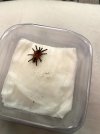
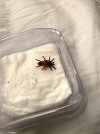
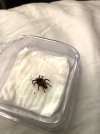
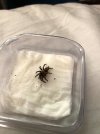
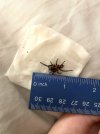


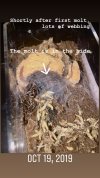

A little background I picked this sling up in August. It has molted twice in my care, once in October (around the 14th) and once this month(around the 4th). I do my feedings on Wednesday and Saturday. The vendor I get my crickets from gets fresh shipments every Tuesday. This leetzi went off feed on 12/14. I journal any time one goes off feed and molts, I only own 11 so I’m still able to keep track of this stuff pretty easily. This was a long premolt compared to the first that only lasted 5 days. It went off October 9th and I found the molt on the 14th. It settled in when I first housed it no issue. I did have to rehouse it October 3 because of mold, but it webbed up its new cork right away and then molted 9-11 days later. I rotated the corner of the substrate I would wet down but never saw it lingering over the moisture. It never really looked stressed either, most days I would find it with its legs dangling out of either end of its tunnel or on top of its cork. I house all my slings on a dresser near my door. It’s a corner of the room that doesn’t get direct air from the vent in my room. My router is on the same dresser to keep a little extra warmth near my slings but I don’t believe it’s close enough to be an issue. We have been running the heater, it’s set to 72°f and I check the enclosures every other day. I have two extremely small Homoeomma Chilensis that I have to keep a close eye on so I just check all the slings. The only thing that stands out to me is that it hasn’t eaten. Even after it’s molt it didn’t look too slimmed down but it’s lost quite a bit of size since it’s molt.
I’m going to attach pictures of the tarantula, old and new, the enclosure as I found it yesterday with the damaged webbing and the shelf where I store my slings. I’ll try and put dates and notes so this all makes sense. I’m also going to stretch it’s legs for a size reference, I don’t believe this was a mature spider, it still has a waxy appearance to its carapace.
I’m sorry this is so long but I really am so upset about this and have no clue where I went wrong with my care. I would love to own this species again, I had such a wonderful time watching it, but not at the expense of another death if it’s something in my care I did wrong.







